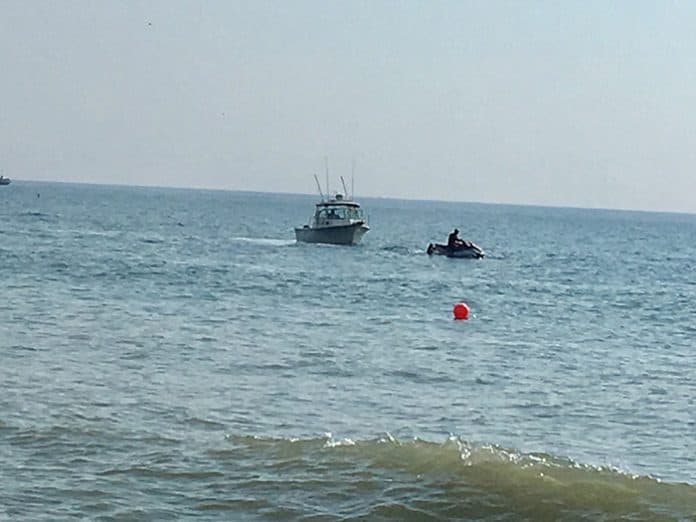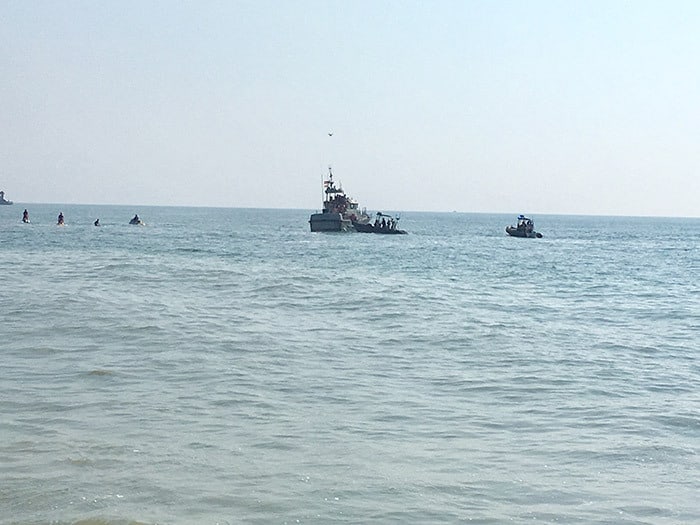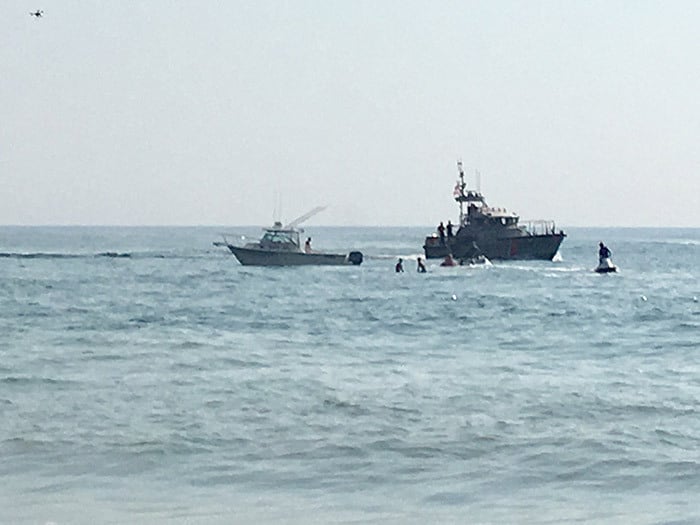
BRICK – Imagine an ocean accident where a 25-foot boat collides with a water scooter in the fog, resulting in five victims being thrown into the water. Rescuers must save the victims – one who has been injured, and another who has drifted hundreds of feet away from the scene of the crash.
That was the scenario in the water off Brick Beach 3 when the Brick Township Office of Emergency Management (OEM) held a drill in coordination with the Coast Guard, township lifeguards, Brick Police, Brick EMS and State Marine Police in a drill to save the victims and to then evaluate their areas of strength and areas in need of improvements.
“Operation Ocean Rescue” was just one of the many coordinated emergency drills practiced here on a regular basis, said Brick Deputy OEM Coordinator Joseph Pawlowicz, who was on the beach with his colleague Joe Gilsenan, Director of Recreation Dan Santaniello, Lifeguard Captain Donovan Brown, Brick Police and Brick EMS.
“Every year we have exercises where we have an operations plan and exercises, such as an active shooter, a chlorine leak at the MUA, an evacuation from the hospital due to a hurricane, and each has a name,” he said.
For example, the year before Superstorm Sandy hit, the township OEM simulated a hospital evacuation and created two operating rooms in the parking lot on hospital grounds, Pawlowicz said.

For Operation Ocean Rescue, a 25-foot Parker fishing vessel (owned and operated by Brick lifeguard supervisor Tim Brennan) with three people aboard collided with a two-person water scooter (also operated by lifeguards) who were all caught off guard by fog that spontaneously rolled in, which made visibility difficult.
In the scenario, the Coast Guard and the State Marine Police were already in the vicinity and responded quickly from the north.
Lifeguards at Brick Beach 3 used their VHF radio to contact the Coast Guard and State Police, and they also alerted Brick EMS and the Brick Police Department, who used their drone to locate the victim who had drifted hundreds of yards away.
The five victims were split into two groups. Brick lifeguards used their beach-based water scooters and responded to both. One of the victims, who had the life-threatening injury, was brought to shore by a lifeguard on the water scooter, and he left a flotation device with the second victim.
Once on land, Brick EMS tended to the victim, while the second water scooter brought another group of two victims to the Coast Guard Cutter. The State Police vessel picked up the remaining victim who had drifted away from the scene of the accident.
Santaniello said that the township has a very good relationship with the Coast Guard and State Police, with each of the rescue boats operated by a former Brick lifeguard.
“We want to make this drill as real as possible,” he said. “When it’s all over, we will debrief and discuss what went well and what didn’t go well.”
Last year’s beach drill was a scenario where a surfer got injured, and the waves were so big he had to be rescued by a boat, Santaniello said.
Santaniello said he is hoping the Brick lifeguards would have a drone next year that could drop a torp (the orange torpedo-shaped flotation devices) out to a victim, could show where rip currents are located, and more.
Three lifeguards would be trained to use the drone, Santaniello said, which is similar to a pilot test.

After Operation Ocean Rescue was over, Gilsenan said they could use some improvement in radio communications between the Coast Guard, State Police and lifeguards.
“We can always improve on communication, that’s always the biggest challenge when you have this many agencies,” he said.
Santaniello said he thought the drill went very well, but there were some areas the lifeguard staff would work on as well.
“We might need more people in command. Donovan Brown was in charge of the 30 lifeguards, but maybe we should have one person in charge of the lifeguards on the water scooters and another in charge of how many lifeguards were in the water,” he said.
“There’s always room for improvement,” Santaniello said.






